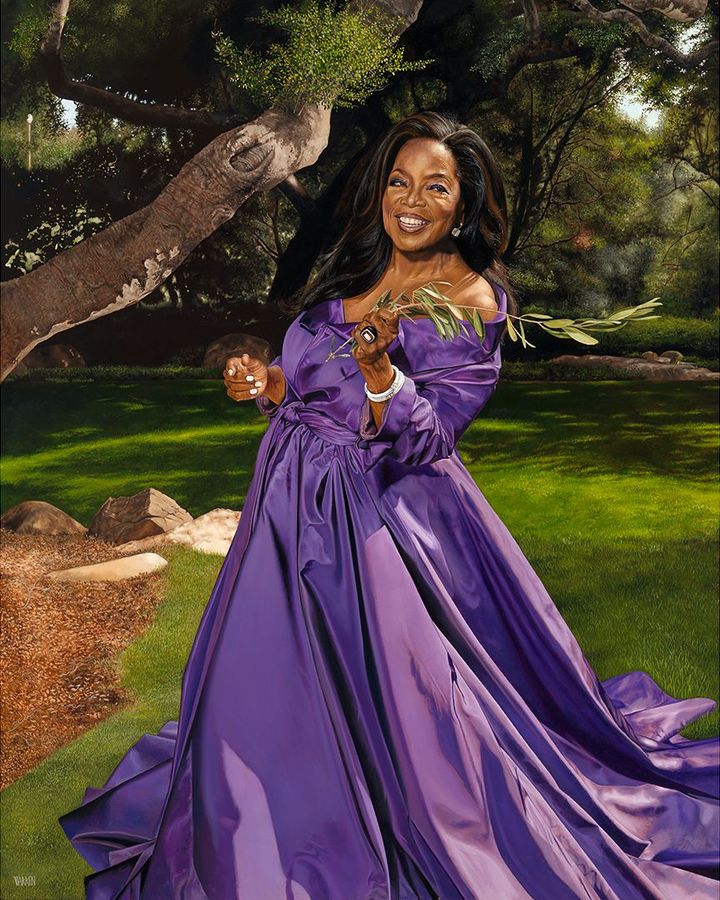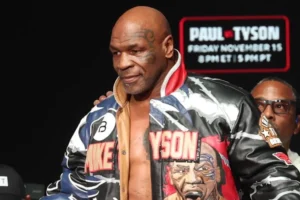A new portrait of Oprah Winfrey has just been unveiled in Washington DC. It draws on symbols used by the Old Masters, and hints at the unexpected origins of the colour purple.
Official portraits have a way of stifling the spirit of their subjects under a heavy varnish of stiff formality. They smother them with self-importance. Only a rare few painted portraits manage to coax to the surface of the canvas some semblance of the sitter’s inner life – the dynamism, dignity, and drive that put the individuals before the easel in the first place. And then there’s Oprah’s.
Unveiled this week at the Smithsonian’s National Portrait Gallery, this merrily luminous full-length oil-on-linen likeness of the acclaimed US talk show host, author, producer, and philanthropist, created by the Chicago-born realist Shawn Michael Warren (whom Winfrey tapped to take on the commission in spring 2021), vibrates with unbounded ebullience. This is Oprah. And then some.
Oprah Winfrey by Shawn Michael Warren (2023) (Credit: National Portrait Gallery, Smithsonian Institution)
It feels fitting that a figure who is revered for her ability to communicate with honest ease and ardent sympathy with audiences across an increasingly divided United States should inspire a portrait that similarly possesses the power to communicate, not just with those who will encounter the work in the coming months and years, but with the whole history of portraiture before it. The arresting painting, which seems to capture Winfrey in a fleeting unguarded moment as she traipses across an evergreen garden in a tornado of purple taffeta, is more than a static snapshot of spontaneous joy.
Warren’s carefully constructed work offers a welcome occasion to remind ourselves how to read a painting, old-school-style – a skill that has slowly slipped amid the endless onslaught of pouty selfies that clogs our screens. Take that dress, for instance. It had to be purple. Winfrey, who rose to prominence in 1985 as a co-star in Steven Spielberg’s adaptation of Alice Walker’s novel The Colour Purple (a powerful role of resilience that earned her both Academy Award and Golden Globe nominations), reflected on her choice of dress during a speech at the unveiling ceremony this week. “The colour purple,” Winfrey said, “to me, is the essence of what God represents: the complications of making the colour purple and its simplicity.”
The portrait takes a colour that is saturated in unpleasantness and privilege and recasts it as something new
That disconnect has defined the colour’s aura for centuries, particularly as it relates to so-called Tyrian purple, an ancient dye that was once reserved for enrobing royalty. Distilled since antiquity from mucus secretions collected from sea snails, purple’s odious origins were always at odds with the simple regality of its symbolism.
A cultural thread can be stretched from the flowing gowns of the floating angel in the Italian High Renaissance master Raphael’s early oil-on-wood The Resurrection of Christ to the jaunty flounce of Oprah’s own purple gown. Both depictions, old and new, manage to take a colour that is saturated in unpleasantness and privilege and recast it as something pure and new.
A symbol of peace and strength
It isn’t only what Winfrey is wearing that intrigues. She is portrayed holding a long olive branch, an age-old symbol of peace that recurs in art history from Ancient Egyptian fresco fragments to Picasso’s dove of peace. But here, the sprig does not appear to be one that Winfrey is intending to offer to another as a gesture of friendship, reconciliation, or unity. Far from it. She is left-handed and appears firmly to be clenching the stem with conspicuous strength in her dominant fist, as if she is about to pierce or puncture something with it – to make a point.
Here, the olive branch is not an indication of meek mindedness or the psyche of surrender, but seems to signal a circumspect ethos of “peace through strength”, as cautious leaders like to say. A portrait of Queen Elizabeth I by the Flemish master Marcus Gheeraerts the Elder, painted between 1580 and 1585, springs to mind. There, the impassive Queen twiddles an olive branch in her fingers amiably enough while, at the same time, tapping her right toe on the sword of Justice (symbol of her supreme power) that lies at her feet. You know, just in case. Shuttle your eyes back and forth between the sharp end of the snapped stem Winfrey is holding and her winning grin, and one begins to sense a slightly steely edge to the momentary mirth – a cautious resolve.
Is there reason to assume Warren is astutely steeped in the history of art, its symbols and subtleties, or intent on transforming tradition? Earlier portraits by the artist, such as one of the fictional matriarch of the island of California, Queen Calafia (the creation of Spanish poet Garci Rodríguez de Montalvo – Warren’s painting hangs in the US Embassy in Madrid), bristle with comparable intensity and allusions.
Warren knows his artistic forebears and isn’t afraid to summon and spar with them in powerful paintings and murals that reveal his attentiveness to historical research. Untrained until he entered the American Academy of the Art as a college student, Warren cut his teeth scrutinising the work of Old Masters in Florence – an assiduousness that is evident in his colossal, almost sculptural portrait-mural of Martin Luther King, Jr. In the figure of Oprah Winfrey, who commands an impressively far-reaching respect in American life, Warren was charged with his most challenging subject yet – a living national treasure. Did he succeed? And then some.
Source: BBC
















